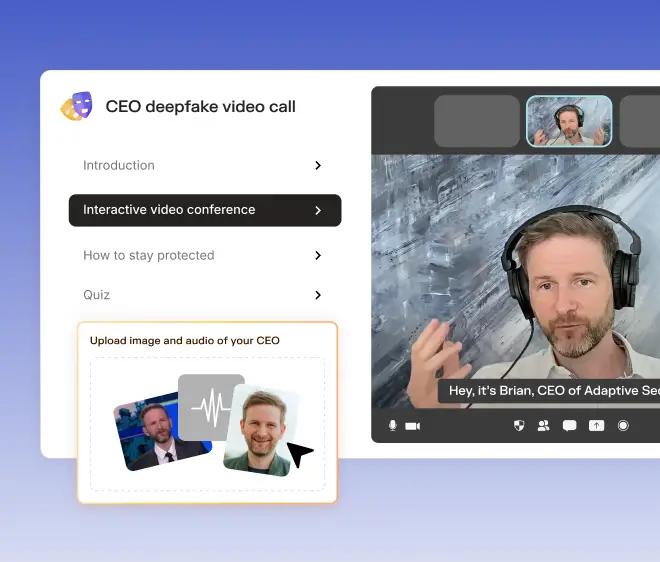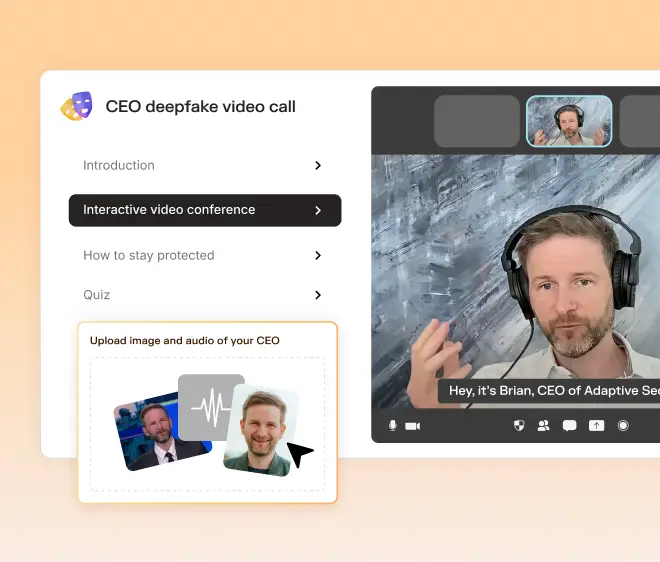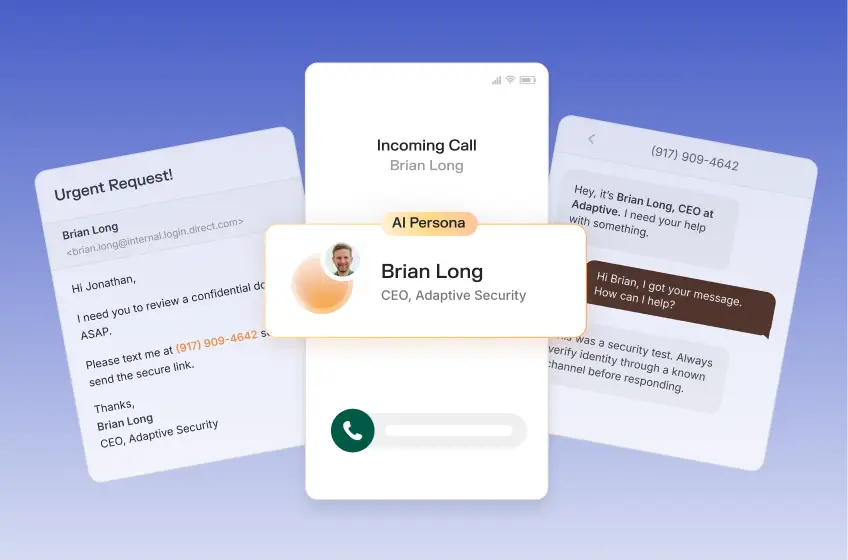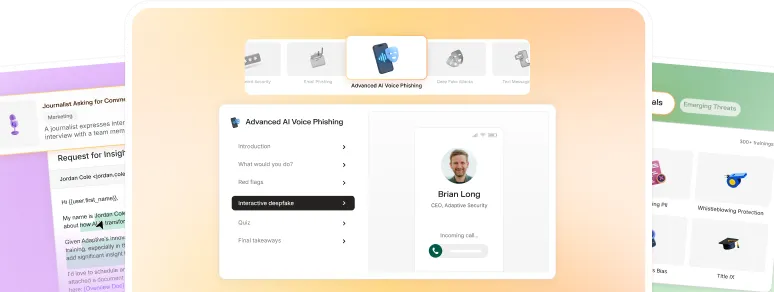By 2029, the global cost of cybercrime is expected to increase to $15.63 trillion. Cybercriminals are after your organization’s sensitive information, using artificial intelligence and social engineering techniques to create modern, convincing deepfakes to trick your employees.
Traditional security awareness programs are not nearly advanced enough to prepare employees for these sophisticated threats. Combating advanced deepfake scams requires a comprehensive understanding of the methods and the premier security awareness training tool on the market.
Adaptive Security uses generative AI technology to test employee responses in realistic deepfake scenarios and identify behavioral risks. In this article, we’ll explore what deepfake scams are, their real-world implications, and how Adaptive can help you defend against them.
Every case reveals the same weakness: humans trust realism more than context, which is exactly what attackers exploit.
What are deepfake scams?
Deepfakes are AI-generated images, videos, or audio that convincingly depict people saying or doing things they never actually did by manipulating faces and/or synthesizing voices. These fabrications use a combination of AI models and social engineering to conduct sophisticated attacks by impersonating executives or trusted contacts.
Deepfakes are a type of phishing—a tactic where attackers pretend to be a legitimate source and deceive individuals into sharing sensitive information or taking harmful actions. Free AI tools can now clone a person's voice in under 60 seconds, making deepfakes cheap, fast, and available to anyone with malicious intent. These kinds of advanced attacks manipulate trust and use psychological tactics like creating a false sense of urgency.
Types of deepfake scams
Deepfake fraud caused American companies to lose over $200 million in the first three months of 2025 alone, yet the average cost of making a deepfake is less than two U.S. dollars. But fraudsters are willing to spend even more time and money to create convincing deepfake attacks that target employees.
These scams take many different forms, including:
- Executive impersonation: Threat actors use AI to convincingly mimic an executive’s face, voice, or style across multiple channels.
- Vendor fraud: Attackers pose as a third-party vendor, typically demanding invoice payment or requesting payment information.
- Voicemail phishing: Scammers use AI voice cloning technology to mimic an authority figure—usually an executive or vendor, but sometimes a personal loved one.
- Deepfake Zoom attacks: Criminals use real-time face swapping, AI voice cloning, and scripted social engineering to impersonate authority personnel during live calls.
Clearly, cybercriminals use increasingly creative techniques and aren’t limited to a specific threat vector. Attackers mine for information using family members’ social media, recorded speeches, company websites, LinkedIn, hacked data, and more. They then use this data to create highly realistic deepfakes.
From hype to harm: real-world cases of deepfake fraud
Cybercriminals aren’t the boogeyman—they’re real threats that can cause irreparable damage. These two major incidents reveal just how convincingly synthetic media can be used to manipulate trusted communication channels through AI-powered impersonation, urgency tactics, and multi-channel spoofing. Deepfakes can now bypass traditional authentication checks by exploiting human trust in familiar voices and seemingly credible context.
$243,000 fraud
In March 2019, a U.K.-based energy company lost $243,000 after cybercriminals cloned the CEO’s voice using AI, called the finance director, and instructed him to transfer funds to a “supplier” in Hungary. The fraudsters mimicked the CEO’s tone, accent, and cadence so precisely that the director believed the call was authentic.
The attackers added urgency to the request, exploiting authority bias and thereby bypassing normal verification procedures. Once the funds were wired to Hungary, they were quickly rerouted across several bank accounts, making recovery impossible.
$25 million fraud
In 2024, a Hong Kong corporation fell victim to a $25 million deepfake scam. Criminals cloned the CFO’s voice and paired it with spoofed emails that matched legitimate business operations. The impersonated executive called a senior colleague to request an “urgent acquisition payment.”
This request was reinforced by seemingly authentic follow-up emails; the target complied, transferring the funds to offshore accounts controlled by the attackers. The funds were never recovered.
Deepfake scam defense that actually works
These security awareness training methods actually prepare employees for the worst attacks.
1. Targeted behavioral training, not just awareness
Basic awareness isn’t enough to defend against social engineering attacks. Not every employee faces the same threats or has the same level of understanding of deepfakes.
For example, an HR manager might face risks tied to employee information, while someone in finance is far more likely to be targeted with invoice fraud or executive impersonation attempts.
Targeted behavioral training solves this by personalizing learning to each role’s unique risk profile and employee awareness. Modern platforms like Adaptive Security analyze user behavior, responsibilities, and threat exposure.The platform then uses this information to deliver realistic, role-specific scenarios.
Adaptive’s methods include behavioral training on a range of attack vectors, including phishing simulations across email, voice, and SMS.
2. Simulation-first security culture
A simulation-first security culture tests employees with highly realistic attacks, including all varieties of deepfakes and phishing. This helps them build the reflexes they need to spot sophisticated threats.
For example, an employee in the finance department spends their workday answering emails, creating reports, and leading team meetings. They hop on a video call, but things look “off.” It appears to be their CFO saying their team missed a vendor payment, and now the invoice needs to be rushed.
The employee recognizes the attempted deepfake attack. Why? Because last month, they failed a simulation security and watched the targeted micro-lessons that clearly showed what they missed. They don’t pay the invoice as requested and alert the proper reporting channels.
At Adaptive Security, simulations are designed using personalized company information and AI-generated content. This way, employees can train against the exact types of attacks they may face.
With Adaptive simulations, organizations receive:
- Unlimited customization: The platform’s GenAI content studio lets you quickly tailor over 100 modules or create new training content in minutes.
- Role-based personalization: Simulations and deepfakes reflect each employee’s risk profile using company open-source intelligence (OSINT).
- Frictionless deployment: Two-click integrations and board-ready reporting makes it easy to launch fully customized training campaigns.
3. Layered verification protocols
Proper verification protocols range depending on the size and needs of an organization. However, it’s common that employees must run at least two verification checks.
The concept of a layered verification protocol is of no help if employees don’t use it. A culture of appropriate caution and adherence encourages employees to use appropriate verification. It becomes an automatic behavior that blends in with their regular workday tasks.
Examples of verification methods that validate sensitive requests during live interactions include:
- Out-of-band callback: End the current session and return the call using a pre-verified number from the company’s secure directory.
- Pre-shared code phrases: Use rotating daily or weekly code phrases known only to the executive and authorized staff to confirm identity.
- Dual approval for high-risk actions: Require a second executive or financial controller to approve all major wire transfers or access escalations.
Why Adaptive Security is built for the deepfake era
The era of AI-powered social engineering is here. Attackers are using real-time deepfake voice cloning, fake executive Zoom calls, and hyper-targeted phishing to bypass legacy defenses. Adaptive Security was built specifically to combat these threats by training employees to detect the tactics attackers use.
The next-generation training platform goes beyond static examples. Adaptive simulates deepfake and phishing attacks with a high level of accuracy in a controlled training environment. All simulations and training modules are tailored to the employee’s department, role, and access level. For example:
- Finance staff may get a deepfake CFO requesting an urgent wire transfer.
- IT admins may face a fake “vendor” using a cloned voice to request credentials.
- HR teams may encounter impersonated internal leadership in a “policy update” video.
Adaptive turns deepfake training from a one-off exercise into a continuous, data-driven defense mechanism. The platform measures your training outcomes, tracking which employees recognized the deepfake, how fast they responded to the lure, and what actions they took (clicking, forwarding, reporting). These insights then feed back into your security program to refine training based on real behavior.
Organizations using Adaptive's deepfake simulations report 40% faster threat recognition and stronger reporting behavior across departments. Adaptive lets you easily see your own CEO deepfaked in a demo scenario, so you can see firsthand how convincing these next-gen deepfakes are.
Don’t react to deepfakes, rehearse for them
Your employees can’t afford to rely on traditional awareness slideshows or annual training refreshers to combat these modern deepfake threats. Instead, they need real-world practice in recognizing and responding to evolving, AI-powered attacks.
The best preparation isn’t reaction; it's simulation. By rehearsing deepfake and phishing scenarios before they happen, your team develops the reflexes to spot subtle tells, verify requests, and stop fraud in its tracks.
Book a demo to see how Adaptive can prepare your organization for AI-era threats.
FAQs about deepfake scams
How common are deepfake cyberattacks?
Audio, image, and video deepfakes are a present and growing threat to all organizations. A 2025 survey of over 300 cybersecurity leaders found that 62% of organizations faced a deepfake cyberattack in the last year.
Why are deepfake scams so effective?
Deepfake scams are so effective because they combine hyper-realistic AI-generated media with proven social engineering tactics that exploit human trust, authority, and a sense of urgency. These scams are psychologically persuasive and difficult to detect by untrained employees.
Can traditional phishing training stop deepfake scams?
Yes, it’s possible that traditional phishing training can stop deepfake scams, largely because any preparation is better than no preparation. However, traditional cybersecurity training doesn't adequately prepare employees to identify and combat modern deepfake technology.
Adaptive is specifically designed for deepfake scam awareness and prevention, simulating AI-generated deepfakes with the same tactics scammers use.
How can I protect my organization against deepfake phishing scams?
The best way to protect your organization is through security awareness training that involves deepfake scenario training and phishing attack simulations.




We are a team of passionate technologists. Adaptive is building a platform that’s tailor-made for helping every company embrace this new era of technology without compromising on security.
Contents



Want to download an asset from our site?





.avif)




.avif)



